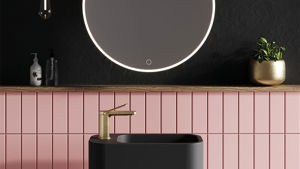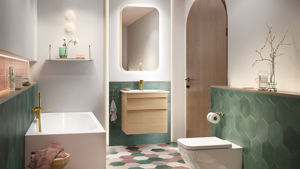The bathroom has always been a functional room in the home, but thanks to the rise of home and decor influencers and insta-upgrades, having a beautiful bathroom has become one of the most sought after renovations. But in stark contrast, we have uncovered some alarming data about the state of bathrooms inside the UK’s social housing, which shows that for a large proportion of the UK, the right to a fit-for-purpose and functional bathroom just isn’t the case.
The Unsuitable Bathrooms Study 2025
While more than three million posts on Instagram are using the hashtags bathroom inspo or bathroom inspiration, there are many living up and down the country without the basic conditions we all take for granted.
In the UK alone, approximately four million households live in social housing. This includes both local authority housing and housing association homes. Our report shows that thousands are battling leaks, mould and broken fixtures in bathrooms on a daily basis, with local authorities recording a slew of complaints and repair requests for their properties. Furthermore, the data shows that in some cases, households are living with some of these issues for months at a time - without being able to take matters into their own hands because of cost, time or general know-how.
To carry out this study, we issued FOI requests to 173 of the UK’s local authorities, requesting information pertaining to the number of bathroom-related complaints and works carried out within a 12-month period from January 2024 to December 2024. Of those 173 contacted, 80 councils responded which informed the data.
Blockages, leaks and mould among the Nation's top bathroom complaints
A deeper look into the thousands of logged complaints revealed that blockages were the most common recorded issue for the local authorities that took part in the study throughout 2024, totalling 1,407 cases. Among these were blockages to sinks and drains but more than a third were related to blocked toilets. On top of these blockages, there were a further 545 complaints relating to toilet issues, such as cistern repairs, suggesting people are having to navigate even the most basic daily acts with difficulty.
Complaint & Repair Reason |
Complaint & Repair Count |
Time for resolution (days) |
| Clear blockage | 1,407 | 23 |
| Bathroom general | 840 | 26 |
| Leak | 798 | 44 |
| Damp/mould | 714 | 82 |
| Issue with light fixture | 707 | 21 |
| Toilet issues | 545 | 44 |
| Doors/ windows | 524 | 28 |
| Extractor fans | 437 | 31 |
| Shower/ Bath issues | 314 | 48 |
| Flooring/ tiling issues | 280 | 41 |
| Others | 254 | 141 |
| Taps | 94 | 31 |
| Heating/Hot Water/Plumbing | 84 | 52 |
| Adaptations | 80 | 37 |
| Sink Issues | 71 | 27 |
| Inspection Required | 16 | - |
| Staff Issues | 14 | 84 |
| Radiators | 12 | 48 |
| Kitchen General | 4 | 132 |
General bathroom complaints were coming in a close second with 840 throughout the course of the year. Instances ranged from replacing bathroom suites to carrying out bathroom adaptations. Bathrooms are generally adapted to make sure they are safe and accessible for individuals with mobility limitations or other disabilities, allowing them to maintain personal hygiene and independence. The data suggests that there are cases where individuals are left waiting for these types of upgrades for as long as 26 days.
Leaks ranked third with around 11% of complaints. Cases reported included general leaks, roof leaks and leaking taps. With water bills at an all-time high, we should all be looking at ways to save water, and a leaking tap left unfixed can make costs start to spiral. A tap dripping at a rate of 240 times in a minute - or four per second - can cost an extra £52 a year on water bills.
Typically, a leaking tap is caused by a degraded tap washer but many don’t know or have the means to fix this themselves. In fact, a tap washer costs as little as 17p and can be fixed in 7 simple steps.
1 in 10 living with damp and mould for up to 3 months at a time
Our study into unsuitable bathrooms in the UK found around 10% of homes were complaining about damp and mould issues. In many cases of damp and mould structural issues are causing the problem, and this will need to be addressed by a professional adding to wait times. However, it’s important to note that all homes can be at risk of developing damp and mould if they are not adequately ventilated.
You can limit up to 75% of the moisture that will lead to mould by wiping down wet surfaces around the bath, shower and sink after use. Interestingly, problems with bathroom extractor fans resulted in 6% of complaints last year. Extractor fans can really help to improve ventilation in the bathroom and reduce condensation which can lead to mould. Running the fan for at least 20 minutes during and after your shower is a really effective way to prevent mould.
Awaab's Law
In 2023, Awaab's Law, named in memory of two-year old Awaab Ishak who tragically died following prolonged exposure to damp and mould, was passed and enacted through the Social Housing (Regulation) Act 2023. From October 2025, social landlords will be forced to investigate and fix dangerous damp and mould in set time periods, as well as repair all emergency hazards within 24 hours.
Awaab's Law will expand in 2026. In addition to damp and mould, other hazards, such as excess cold and excess heat, falls, structural collapse, fire, electrical and hygiene hazards, are expected to be included within the regulations. And, in 2027, the requirement's of Awaab's Law will expand to the remaining hazards as defined by the HHRS (Housing Health and Safety Rating System).
Despite changes to regulations and timeframes specifically relating to damp and mould coming in to force in October this year, the data collated within our report suggested that resolution times during 2024 were still very lengthy with some waiting as long as 82 days for damp and mould issues in the bathroom to be resolved.
Living with mould can cause a range of health problems, particularly respiratory issues and allergic reactions. Inhaling mould spores can trigger sneezing, runny nose, eye irritation and even asthma attacks. Individuals with weakened immune systems or existing respiratory conditions are more susceptible to severe reactions.
37 days average wait time for repair of bathroom-related complaints
We would hope that any bathroom complaint be treated as soon as possible, however the data within our study revealed that Brits are left with unsuitable bathrooms for an average of 37 days before the issue is fixed.
In addition to damp and mould issues, plumbing issues were taking the longest to fix. In fact, homes that have reported having heating, hot water or plumbing issues must wait an average of 52 days, which is an alarming amount considering how cold our homes can get over the winter.
Complaint & Repair Reason |
Time For Resolution (Days) |
Complaint & Repair Count |
| Damp/ Mould | 82 | 714 |
| Heating/ Hot water/ Plumbing | 52 | 84 |
| Shower/ Bath Issues | 48 | 314 |
| Radiators | 48 | 12 |
| Toilet issues | 44 | 545 |
| Leak | 44 | 798 |
| Flooring/ tiling issues | 41 | 280 |
| Adaptations | 37 | 80 |
| Taps | 31 | 94 |
| Extractor Fans | 31 | 437 |
Problems with showers and baths were the third most common complaint with the longest wait times, averaging 48 days for resolution. These figures suggest that many people are going without a working shower for over a month - or worse, without heating for nearly two months.
January is the worst month for our bathrooms
With mould ranking highly among the reported complaints, it may come as no surprise that our study revealed January was the month when bathroom issues were most likely to be raised. The first month of the year accounted for 18% of complaints and repair requests which could be in part due to the cold weather wreaking havoc with pipes and indoor humidity levels.
Month |
% of complaints and repair requests |
| January | 18% |
| March | 16% |
| December | 14% |
| February | 12% |
| April | 9% |
March ranked second followed by December, February and April in third, fourth and fifth respectively. Interestingly, all months in the top five with the most complaints and requests for bathroom work were in winter or spring, with none occurring in summer or autumn - this could be due to the colder and wetter weather that comes at the end and the start of the year causing issues to become more exposed.
The Unsuitable Bathroom Study 2025 was compiled following FOI requests to local authorities requesting information pertaining to the number of bathroom-related complaints and works carried out within a 12-month period from January 2024 to December 2024. 80 councils responded which informed the data.








